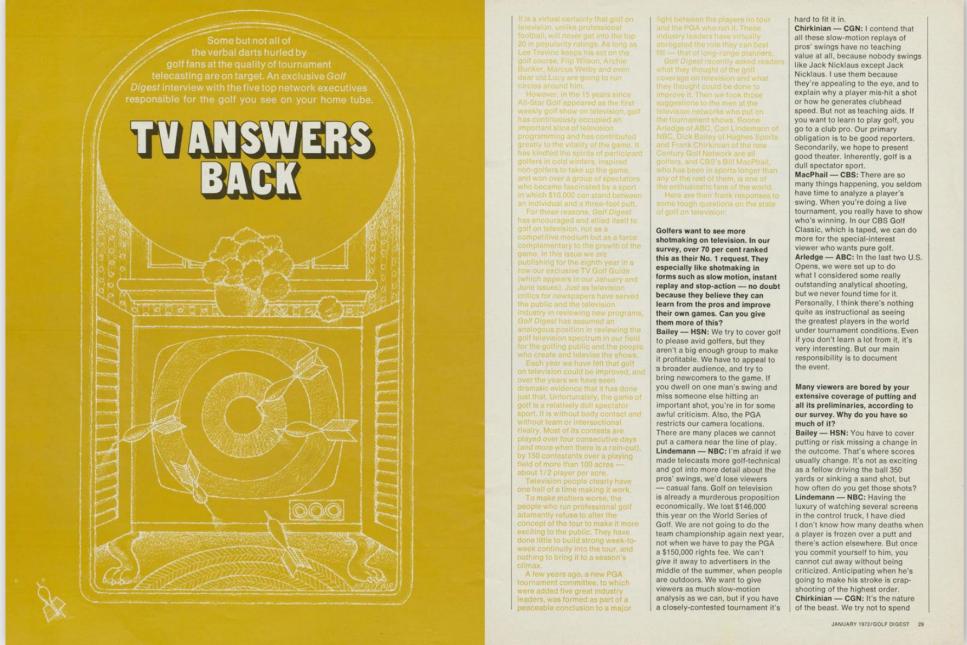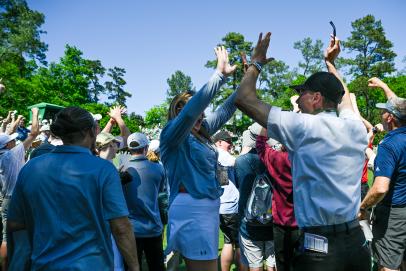From the Archive
You'll feel deja vu when reading this Golf Digest story about the trouble with golf coverage on TV … from 1972

Sam Greenwood
There has been lots of handwringing about golf on TV in 2024, from ratings declines to complaints about too many commercials to frustrations over not enough live coverage.
And yet there’s been lots of handwringing about golf on TV for years. Listen to hear if this sounds at all familiar: Golf Digest surveyed fans who watch golf on TV and more than 70 percent noted the desire to see more shots during broadcasts as their No. 1 request.
So when did that survey take place? In 2023? Earlier this year?
How about late 1971?
More than five decades ago, Golf Digest took an in-depth look at golf on television with a story in the January 1972 issue headlined “TV Answers Back.” In the introduction of the piece, Golf Digest explained the challenges facing golf broadcasts—high costs for production, difficulty covering all 18 holes and squeezing in all the relevant shots. Then the magazine opened things up to five of the industry’s most powerful executives—Roone Arledge of ABC; Carl Lindemann of NBC; Dick Bailey of Hughes Sports; Frank Chirkinian identified as being with the new Century Golf Network but also connected to CBS; and CBS veteran Bill MacPhail—to address concerns viewers voiced and explore where things might be headed in the future.
You can read the story in its entirety here, and we encourage you to do that—if for no other reason than to see how much progress actually has been made over the years. Progress in technology, of course, but also from a creativity standpoint.
(Golf Digest+ members get access to the complete Golf Digest archive dating back to 1950. Sign up here.)
Case in point: When the question was raised about showing more than just the finishing holes of a tournament, which was the common practice at the time, MacPhail had this comment, hinting at an old-school train of thought:
“I don’t see any reason to do more holes than we’re doing. There’s only one screen, and you can only see one thing at a time, and we’d just tend to get more gimmicky. Too gimmicky.”
Arledge then offered his thoughts: “What I’d like to be able to do is cover all 18 holes. But the cost of producing golf already is staggering, and with the action so spread out you have tremendous logistical problems. It’s very hard to get a signal from all parts of the course. The players demand absence of noise, so we are unable to move equipment the way we would at a football game, for instance. A quarterback is not distracted by a camera moving along the sideline, but a golfer is.”

Again, many on social media gripe about how stale today’s coverage is, but it’s miles better (as it should be) from when networks were first starting to get serious about golf.
Early in the story, Golf Digest noted just why golf on TV has a unique potential to appeal to viewers: “It has kindled the spirits of participant golfers in cold winters, inspired non-golfers to take up the game, and won over a group of spectators who became fascinated by a sport in which $10,000 can stand between an individual and a three-foot putt.”
Kind of quaint to see $10,000 being considered high stakes.
Several of the participants took great pains to express how expensive covering golf was on TV, another lament that continues today. NBC’s Lindemann was most direct: “Golf on television is already a murderous proposition economically. We lost $146,000 this year on the World Series of Golf. We are not going to do the team championship again next year, not when we have to pay the PGA a $150,000 rights fee. We can’t give it away to advertisers in the middle of the summer, when people are outdoors.”
Meanwhile, if you think the pro tours—or the players competing—provide impediments to coverage currently, consider what Golf Digest editorialized:
“To make matters worse, the people who run professional golf adamantly refuse to alter the concept of the tour to make it more exciting to the public. They have done little to build strong week-to-week continuity into the tour, and nothing to bring it to a season’s climax.”
Suffice to say, we might have foreshadowed the comping Tour Championship and the eventual creation of the FedEx Cup Playoffs.
There was also an interesting exchange about finding the right people to call the action, specifically the importance of having a “golf expert” in the booth. The executives echoed one in another in saying that finding a good fit was tricky because taking the expert and training him to be an announcer was too difficult. Seems like something the folks at NBC are wrestling with right now, too.


